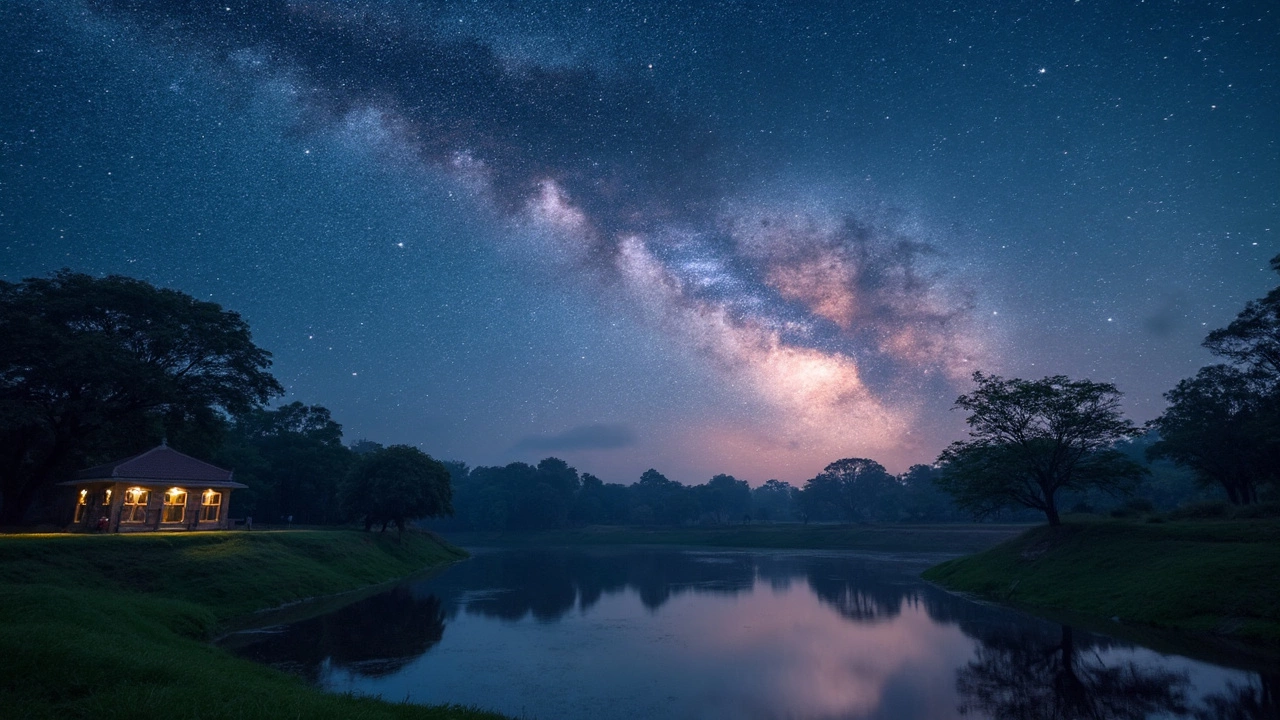Exploring India's Dark Sky Reserve: A Stargazer's Paradise
 Feb, 14 2025
Feb, 14 2025
Imagine a place where the night sky is so clear that you can see the Milky Way stretching across the heavens, unspoiled by light pollution. That's what India’s dark sky reserves offer—a true stargazer's paradise. Whether you're an astronomy buff or just someone who appreciates a good view, these places are worth checking out.
Dark sky reserves are special areas dedicated to preserving the night sky's natural beauty. They're not just about keeping the lights down; they're about maintaining the environment, blending cultural significance with ecological conservation. In India, these reserves play a crucial role in promoting cultural tourism by offering a unique glimpse into our universe.
- Understanding Dark Sky Reserves
- The Significance of India's Dark Sky Reserve
- Cultural and Ecological Impact
- Tips for Stargazing Adventures
Understanding Dark Sky Reserves
So, what exactly is a dark sky reserve? Simply put, it's a special spot where light pollution is kept to a minimum, allowing the night skies to shine just like they did way back when our ancestors first looked up in wonder. Think of them as nature's very own planetariums, minus the digital effects.
Why They Matter
Saving these patches of darkness isn't just about getting cool views. It's about preserving the heritage of our night skies and ensuring that future generations can still enjoy the glittering tapestry above. Plus, dark skies are super important for nocturnal wildlife, helping critters stick to their natural rhythms.
How It Works
Creating a dark sky reserve involves more than just turning down the lights. It often means collaborating with local communities, governments, and environmental groups to regulate artificial lighting and promote eco-friendly practices. This way the area stays as naturally dark as possible. UNESCO and the International Dark-Sky Association often recognize these areas officially.
Stats to Know
Worldwide, there are roughly 130 designated dark sky reserves. From small towns to sprawling national parks, they span across various countries. In India, moves are being made to safeguard these natural wonders as part of cultural tourism. It's not just about stargazing; it's about building awareness and appreciation for the natural night environment.
- Location: Usually found in remote locations with low human population density.
- Rules: Areas within the reserves limit outdoor lighting and often use downcast, shielded fixtures.
- Benefits: Fosters local tourism while promoting education and research opportunities.
By protecting these dark sky areas, we're also shedding light—pun intended—on the importance of sustainable living and environmental consciousness.
The Significance of India's Dark Sky Reserve
India’s dark sky reserves aren't just about pretty night views—they're a big deal for several reasons. These specially designated spots, like Ladakh’s Hanle as part of the Changthang Wildlife Sanctuary, are a boon for stargazing without the interference of urban glow.
One of the major benefits of these reserves is their role in preserving ecosystems. Many creatures rely on the natural cycles of light and dark. By reducing artificial light, dark sky reserves help protect wildlife habitats and sustain biodiversity.
Aside from environmental perks, there's a rich cultural aspect here too. Stargazing has deep roots in Indian history, with ancient texts charting the movement of celestial bodies. Today, these reserves offer a chance to connect with that heritage, appealing to both locals and tourists looking to explore
cultural tourism in India.
Boosting Local Economies
Dark sky reserves are also great for local economies. By attracting tourists and astronomy enthusiasts from around the globe, they support small businesses and promote development in remote areas. This eco-friendly tourism model brings income but keeps the environment intact, a win-win situation.
Why It Matters
- Educating the Public: These reserves serve as important educational hubs, where people can learn about astronomy, conservation, and more.
- Promoting Awareness: They highlight the negative impact of light pollution, driving conversations about sustainable practices.
In a nutshell, India’s dark sky reserves are a blend of science, tourism, and cultural heritage. They play a crucial role in promoting cultural tourism, enhancing local economies, and providing a natural sanctuary for both wildlife and humans.

Cultural and Ecological Impact
India's dark sky reserves are much more than just spots for gazing at stars. They have profound cultural and ecological significance that ties into the heart of the communities around them.
Blending Culture and Nature
Dark sky reserves in India often overlap with areas of cultural importance. For instance, many are located near ancient sites, adding a layer of cultural richness to the experience. It’s like taking a journey through time where the starry skies hold the same awe they did thousands of years ago.
Preserving the Ecosystem
Besides fostering tourism, these reserves play a crucial role in preserving local ecosystems. They help protect nocturnal wildlife that rely on natural light cycles. Light pollution can disrupt these cycles, affecting everything from plant growth to animal behavior. Speaking of which, a study by the India Environment Agency revealed, "Reducing light pollution benefits not only the natural environment but also boosts biodiversity".
Moreover, these areas can be a source of community pride and a catalyst for educational initiatives, encouraging young minds to explore astronomy and environmental conservation.
"In committing to dark sky reserves, we embrace both our stars and our heritage," remarks Dr. Aparna Singh from the Indian Institute of Astrophysics.
Engaging Local Communities
Local communities often get involved, offering guided tours and workshops that provide visitors with deeper insights into both the night sky and the region's culture. This not only boosts local economies but also increases awareness about the importance of preserving dark skies.
So next time you're planning a trip, think about checking out a dark sky reserve. It's not just about spotting constellations; it's a step towards understanding how interconnected we are with the universe and our heritage.
Tips for Stargazing Adventures
Ready to embark on a journey to explore the nighttime marvels of India's dark sky reserve? Here are some practical tips to enhance your stargazing experience.
Plan Ahead
The first step to a successful stargazing adventure is planning. Check the weather forecast to ensure clear skies. Cloudy nights won't help you see stars! Also, download a stargazing app to help you identify constellations and planets.
Choose the Right Spot
While India offers several dark sky reserves, picking the right spot within can make all the difference. Look for areas away from artificial light sources. The best stargazing spots are usually open areas with minimal obstructions, like large trees or buildings.
Bring the Essentials
- Telescope or Binoculars: While the naked eye is fun, a telescope or good pairs of binoculars can elevate your experience.
- Warm Clothing: Nights can get chilly, so bundle up to stay comfortable.
- Red Light Torch: They're great for navigating without ruining your night vision.
- Snacks and Water: Keep energized while you lie back and watch the stars.
Learn the Night Sky
Before you head out, spend some time learning about the night sky. Familiarize yourself with notable constellations like Orion, Polaris, and the Milky Way band. You'll enjoy it more when you know what you're looking at!
Respect the Environment
Preserving the sanctity of the dark sky reserve is crucial. Always pack out what you bring in and respect local guidelines. Leave no trace, so the area remains pristine for future stargazers.
With these tips, your stargazing adventure in India could easily become one of your most memorable travel experiences. Happy stargazing!